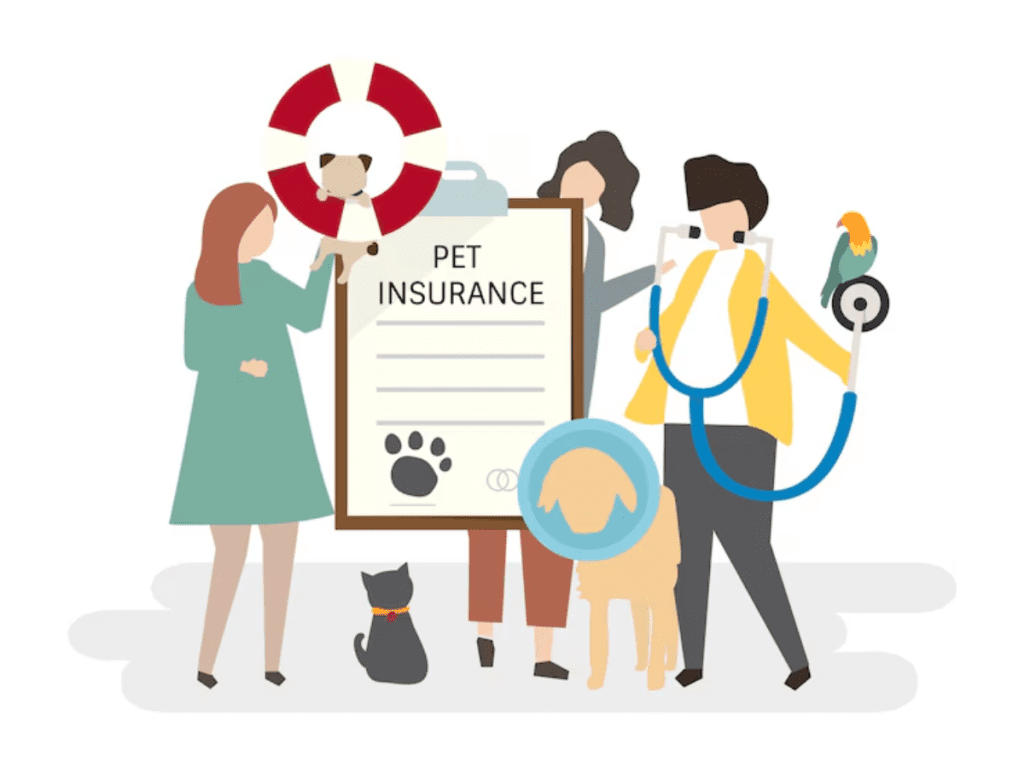Introduction
Pet insurance is more and more becoming a convenient solution for pet owners who want their furry companions to enjoy quality health care without financially burdens themselves Pet insurance is like human health insurance except with significant variations that pet owners need to understand Selecting a pet insurance policy is more than a price comparison It is about comprehending what is included what is excluded and what policy types are available Understanding these differences can enable pet owners to make an educated choice that is in the best interest of their pet’s health and their financial security
How Pet Insurance Works and What to Expect
Pet insurance typically operates on a reimbursement basis When your pet is treated you pay the vet bill upfront and then submit a claim to your insurance company Depending on your policy the company reimburses a percentage of the covered cost after subtracting the agreed deductible Most policies permit you to see your own vet which provides pet owners with a great deal of flexibility Policies vary depending on the deductible you select the percentage of costs reimbursed and the annual or per occurrence limits It is important to know each aspect of your policy because they will dictate how much money you will be reimbursed and what financial obligations will be yours
Accidents and Injury Coverage in Pet Insurance
Accident coverage is a central aspect of the majority of pet insurance policies This covers for unexpected injury such as broken bones bite wounds lacerations burns and foreign object ingestion If your dog ingests a sock or your cat falls from a great height and breaks a limb the related veterinary treatment including surgery anesthesia testing and follow up visits are generally covered by an accident policy Most providers also cover emergency care within accident coverage which can be a huge comfort in desperate circumstances Active pets or pets with access to the outdoors can greatly benefit from this sort of coverage because accidents can suddenly occur and be expensive to treat
Common and Chronic Disease Coverage
Besides accidents most pet insurance policies offer extensive coverage for a variety of illnesses These range from minor ailments like ear infections and digestive problems to life-threatening diseases like cancer diabetes arthritis and thyroid disease Chronic diseases that need extended treatment over time like skin allergies or epilepsy are also usually covered based on the provider and policy conditions Some policies provide lifetime benefits for chronic disease as long as there is continuous coverage without lapse For pet owners with older pets or breeds with specific conditions having illness coverage is essential to providing timely and continuous medical intervention
Hereditary and Congenital Conditions Explained
Certain pet breeds have a genetic susceptibility to certain hereditary or congenital conditions For instance large breeds of dogs are commonly afflicted by hip dysplasia whereas Persian cats are liable to polycystic kidney disease Most contemporary pet insurance policies now cover hereditary and congenital conditions but these tend to have conditions like age limits waiting periods or that the condition must not have been present before buying the policy The coverage can depend on whether the policy is a basic or a comprehensive one Pet owners need to investigate breed related risks and verify if those ailments are covered under the insurance company before buying the policy
Diagnostic Testing and Imaging Services
Veterinary diagnostics are important in diagnosing and treating disease or injury Pet insurance will usually cover diagnostic procedures like blood tests X rays ultrasounds MRIs and CT scans These procedures can be costly particularly when advanced imaging is needed for internal problems Full coverage policies will pay these costs as long as the condition being tested for is included under the policy In other instances diagnostics also involve biopsies and cytology which are necessary for diagnosing cancers or other severe diseases Proper and timely diagnosis results in more effective treatment and improved outcomes which is why this aspect of coverage is so vital
Surgery and Hospitalization Benefits
Surgery whether it is a broken bone tumor removal or internal hemorrhage can run thousands of dollars Most pet insurance policies have surgery included in accident or illness coverage The anesthetic surgical supplies pre and post-operative tests and hospitalization are usually paid for depending on the policy terms Hospitalization can also cover intensive care oxygen therapy or intravenous meds where necessary This is particularly essential in emergency situations where pets require overnight care or observation More advanced policies will even cover surgeries by veterinary specialists so that your pet receives the best treatment possible
Emergency and Urgent Care Coverage
Emergencies are an oncall proposition and can occur at any time demanding instant action. Emergency clinics pay more because of the nature of services offered and schedules Emergency care packages included in pet insurance will pay for emergent visits for covered accidents or diseases These include acute injury seizures or toxic ingestions which are usually addressed with quick intervention and technical assistance Some insurance companies maintain 24 by 7 helplines or telemedicine services which assist pet owners in emergency situations allowing them to make the most informed choice on whether to rush into the clinic or provide treatment at home till proper treatment is sought
Prescription Drugs and Medical Equipment
Prescription drugs are a fundamental component of many treatment regimens and are usually covered if they are for a covered illness This can include antibiotics painkillers insulin allergy treatments and even chemo drugs Some plans also pay for the expense of prescription diets therapeutic supplements and medicated shampoos but only when they are prescribed for a covered disease It is a good idea to read your policy to see if drugs are covered and under what conditions Some plans have more generous drug coverage and others limit the types or length of medication that can be reimbursed
Alternative Therapies and Holistic Treatments
As veterinary care becomes more advanced pet owners are increasingly looking to alternative therapies to enhance their pet’s health and rehabilitation These include chiropractic care laser therapy hydrotherapy acupuncture and physical rehabilitation Not every pet insurance company offers these treatments but some make them available as add-ons to premium packages or optional services These are usually utilized after surgery or to alleviate chronic pain and mobility issues Alternative care coverage can be useful for elderly pets or pets recovering from orthopedic surgeries Pet owners seeking holistic treatment need to carefully assess which companies accommodate these kinds of therapies
Routine Care and Preventive Services
Regular care consists of services intended to prevent illness and keep pets healthy including annual wellness exams vaccinations parasite control dental cleanings and spaying or neutering These are generally not covered under standard pet insurance policies unless the owner buys a wellness plan or preventive care rider Wellness plans are offered as add ons and cover reimbursement for specific services up to a capped dollar amount per year While they raise the premium they also lower out of pocket expenses for regular care keeping pets healthy and getting them regular checkups early detection of disease tends to result in better health outcomes and lower long term costs
Pet Insurance and Dental Health
Dental care is an often-neglected but essential part of pet health Most insurance companies won’t pay for routine dental cleaning as part of the standard policy However if your pet needs dental care as a result of an accident like a cracked tooth or illness like a tooth abscess or gum disease the procedure might be covered Some full-coverage policies provide coverage for periodontal disease if it’s deemed a medical condition and not merely a hygiene problem Pet owners should check if their plan makes a distinction between dental disease and preventive cleaning and what exclusions might be enforced
Pre Existing Conditions and Policy Exclusions
Pre existing conditions are generally not covered This means any illness injury or symptom that was present prior to the policy effective date or in the waiting period Even if the pet was not officially diagnosed but symptoms recorded by veterinarians can exclude future claims for that ailment Some policies provide limited benefits for curable pre existing ailments if the pet is symptom free for a specified period following enrollment Aside from pre existing conditions most policies also exclude cosmetic procedures, elective surgery, breeding or pregnancy related services and behavioral treatments unless otherwise stated
Age and Breed Restrictions in Pet Insurance
Age and breed are important considerations for pet insurance eligibility and price Puppies and kittens are typically eligible for coverage at eight weeks of age whereas many insurers have maximum age limits for joining ranging from ten to fourteen years Older pets can still be insured but with increased premiums and potentially restricted benefits Some breeds predisposed to hereditary health conditions can expect breed specific exclusions or higher rates For instance bulldogs and German shepherds can be more costly to insure because of frequent health issues Pet owners should report their pet’s age and breed accurately when getting quotes to prevent surprise exclusions
Selecting the Appropriate Insurance Policy for Your Pet
Selecting a pet insurance policy must be an informed decision depending on your pet’s health history lifestyle and risk profile Start by determining the degree of coverage you require accident only accident and illness or comprehensive coverage including wellness options Review the deductible options reimbursement percentage and coverage limits provided by various insurers Compare the providers on grounds of transparency of policies customer reviews and ease of claim filing Some providers provide mobile apps that make it easy while others provide direct payment arrangements with veterinary clinics Careful reading of the fine print and knowledge of exclusions are important to secure a policy that meets your expectations and budget

